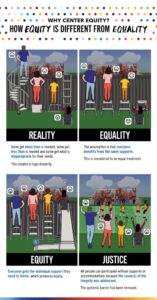Day 2: Why Center Equity?
How Equity is Different from Equality.
How Equity is Different from Equality.
Every moment is an organizing opportunity, every person a potential activist, every minute a chance to change the world.
Welcome to the first full week of the 21-Day Equity Challenge. We enjoyed convening at our kickoff event to commit ourselves to these 21 days and beyond of centering equity in our lives. Day one of the challenge was sent on Friday. If you missed day one, you can find it alongside a running catalogue of challenge days on our website.
When did you first come across the term equity? What did it make you think about? Equity has historically been a term connected to finances, stock shares, bottom lines and their financial stake in something.
This is not the type of equity we center on in this challenge. Equity, when referring to social systems and structures, requires us to look deeper and gives us a clearer understanding of why we see social issues (poverty, hunger, racism, homelessness, homophobia, violence, etc.) in our communities. Equity helps us understand who in our community is more likely to have barriers to fully succeeding and creates conditions where we can work together to build solutions from the assets in our community.
How do we define equity? Equity recognizes that each person is unique with their own strengths and support. What one person may need to achieve full fairness of outcomes may be different from another person. Equity happens when we intentionally include everyone in society based on what specific supports they need to thrive. Equity is achieved when systemic, institutional and historical barriers based on race, gender, sexual orientation and other identities are dismantled and no longer determine socioeconomic, education and health outcomes.
So, how is equity different from equality? Equality is the state of being equal. Equality is achieved when all members of a society have the same rights and opportunities.
The images below can help us better understand the difference between equity and equality.

In the graphic, we get a full picture of the difference in our reality, equality, equity and justice. In each scenario, the number and types of support change based on the unique needs and strengths of each person trying to see the game over the fence. In each image there is an emoji depiction of each person’s experience. Watch as that changes for the entire group as we move toward equity and justice. In the Reality graphic, support is distributed in a way that creates a disparity between each person. It’s important to note that no one in the Reality graphic did anything to receive the support they have access to. The boxes in the Reality image can represent privilege, which is the unearned advantages and disadvantages granted to specific groups of people because of their membership in a social group (review Day 3 What Is Privilege and Power in the 2022 Equity Challenge). In the Equality box, each person is given the same stand to see the game; they have equal treatment yet they all cannot participate in the activity. In the Equity graphic, the stepladder height and ramp change based on each person’s circumstances, so everyone can fully participate in the activity. In our last box we see an example of what it might be like if we removed systemic barriers so that all people could fully participate from the start.
During the 21-Day Equity Challenge and in our work at United Way, we center equity because it calls attention to the systematic barriers people face that lead to unjust outcomes. Equity allows us to find solutions so that each person in our community has what they need to be fully included and thrive. Equity is a process, a tool and a muscle that we all must center in our daily actions and choices. Throughout the challenge, we will use an equity framework to uncover the various systems, policies and power structures that maintain the status quo and create the inequitable outcomes we see today.
As you go through today’s resources, we encourage you to reflect on your own responsibility for centering equity. What would it look like for you to center equity in your home, work, school or community spaces?